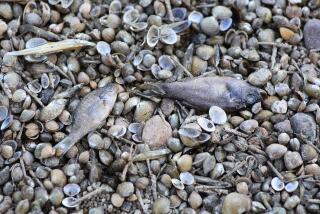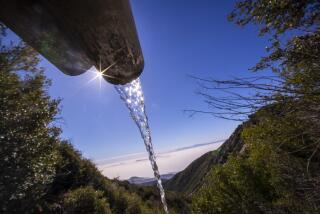Flood Ruptured Ojai Sewer Main, Spilling Waste in Creek
As floodwaters rose in San Antonio Creek last week, the swift current sliced into a dirt embankment, toppled a row of sycamore trees and severed Ojai’s main sewer line.
The break in the 15-inch pipe spewed an estimated 2 million gallons of raw sewage into the creek and down the swollen Ventura River. The spill was reported to state and county officials but not to local residents.
On Thursday, as word of the spill spread, homeowners along the creek expressed surprise and anger.
“They absolutely should have notified us,” said Jamie Skeeters, who boards and trains horses on his Ojai Valley ranch. “That really does upset me because I had ranch hands and trainers wading in the water up to their chest trying to rescue horses.”
Eric Oltmann, general manager of the Ojai Valley Sanitation District, which owns the broken line, said his agency notified the proper authorities about the break.
Authorities at those agencies--the Regional Water Quality Control Board and the county’s Environmental Health Department--said they were not required by law to issue a public advisory.
Moreover, state and county officials say that at the time, other flood-related crises were more urgent and common sense should have kept people away. They note that the sewage carried only a fraction of the bacteria flushed into the river from farm fields, city streets and storm drains.
“There was not a real health risk because of the volume of the water in the river, “ said Winnie Jesena, a senior engineer with the Regional Water Quality Control Board in Los Angeles. “And at that time, the river was not being used for recreational purposes.”
Said Oltmann: “If this were the dry summertime months and no flooding was going on . . . it probably would have been posted and warned.”
Officials say that the sewage has now washed out to sea and poses no health risk.
At the height of the storms, Creek Road was covered with several feet of water, rocks and mud. The winding, rural road, which follows San Antonio Creek, is still closed to traffic except for residents.
Some residents are still trying to scrape away the muck in their homes, barns and garages. They said the sewage spill would have been just one more worry.
“On the whole, it seems like they should have let people know,” said Rose Grimm, a mother of seven who lives on Creek Road. “There have been times when the children were tempted to go down to the creek--not that we would have let them.”
In a similar incident earlier last week, county environmental health officials issued a public advisory after floodwaters overwhelmed the Hill Canyon Treatment Plant, allowing 425,000 gallons of sewage to flow into Calleguas Creek.
Residents were warned to avoid contact with the creek and stay away from the ocean near the creek’s mouth at Point Mugu.
An advisory was not issued for the Ojai spill, in part, because environmental health officials were too busy spreading the word about possible contamination in west Ventura’s water supply.
“At that point, we focused on notifying food facilities about the boil-water order,” said Bob Williamson, a supervisor in the county’s environmental health division. “It was just a question of priorities at that time.”
Ventura city officials said they do not believe the sewage spill was related to a test showing that a portion of the city’s water supply was contaminated with bacteria.
Steve Wilson, who oversees the city’s water treatment operations, said the drinking water was being drawn from below the surface of the river. Those wells, he said, are sealed to keep flowing water out.
Ojai Valley Sanitation District officials said they do not know when the 15-inch trunk line will be permanently repaired.
Jack Curtis, the district’s collection system supervisor, said the 80 feet of pipe that washed out cannot be replaced until the county permanently repairs the shoulder of Creek Road. Otherwise, he said, the pipe could just break loose again.
Meanwhile, district crews are working at the site around the clock to monitor a diesel pump that is being used to siphon sewage out of a manhole and into the temporary, 12-inch pipeline.
The temporary pipe sits along the surface of the road rather than being buried underground, as was the main pipe.
Oltmann said the district will seek reimbursement for the repairs from the Federal Emergency Management Agency. He estimated that it is costing $1,000 a day in salary and overtime for the employees at the site.
More to Read
Sign up for Essential California
The most important California stories and recommendations in your inbox every morning.
You may occasionally receive promotional content from the Los Angeles Times.










